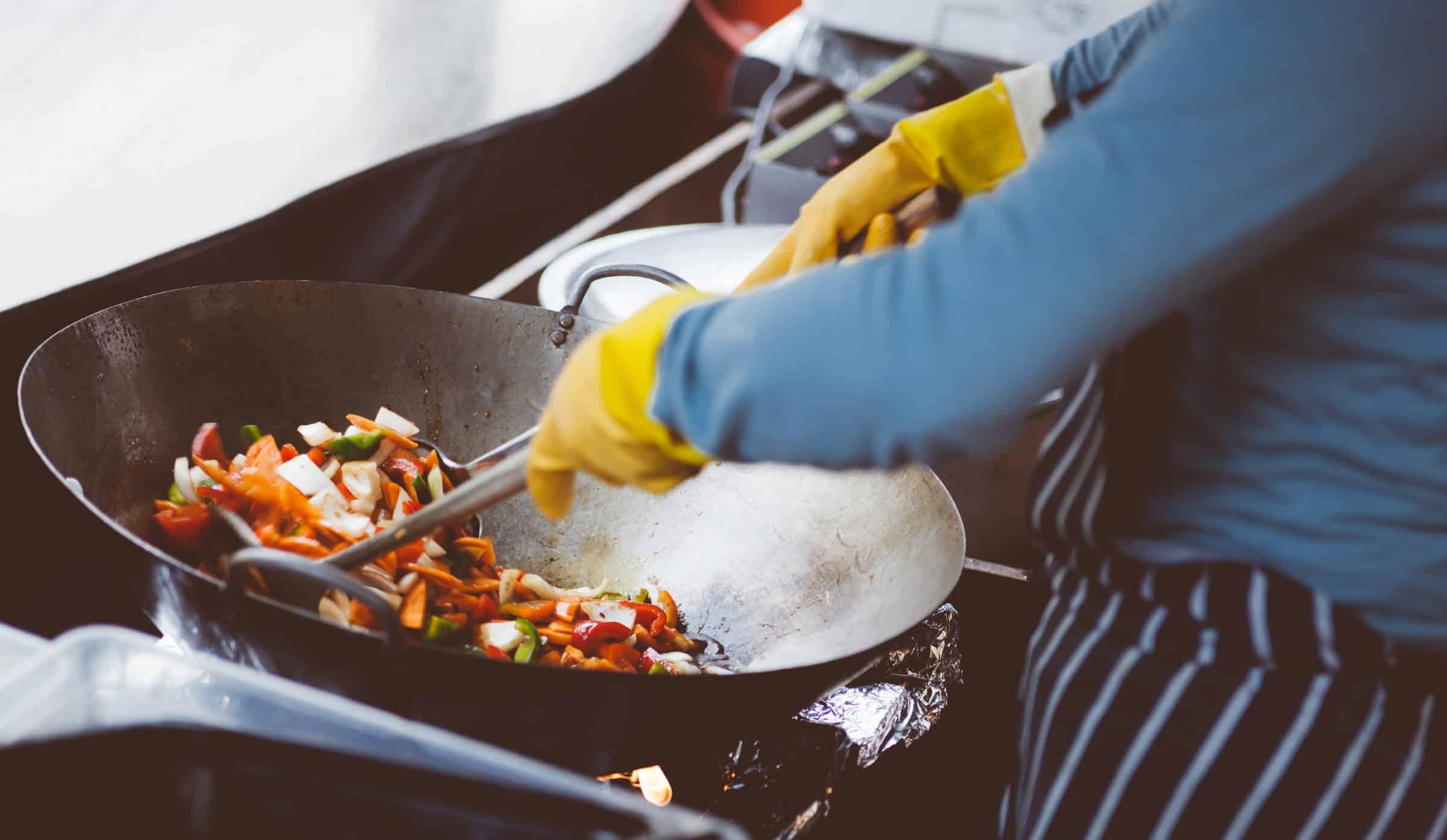Food is one of the nicest and tastiest ways to experience a country during your world trip . And I don’t mean in fancy restaurants – I mean the little plastic tables and chairs on the roadside, aka street food. I’ve also found that talking about food opens doors, puts a smile on faces and makes new friends. Good and tasty food also helps you to be calm and stay positive during your world trip . But to what extent can you safely eat street food during your long journey or world trip?

In this article you will find some well-known tips for eating street food. In addition, a number of less obvious tips from the pros. Tips from real world travelers who have been on the road for years. Are you ready to taste?
Street Food in Asia
Before we start with the list of tips to eat safe street food during your world trip, we want to pre-warm you first. Did you know that Netflix in the Netherlands has a docuseries about street food in Asia has available? I don’t know about you guys, but this is making my mouth water! Watch the trailer below:
Street Food in Latin America
The sequel of Streetfood in Asia is here: streetfood in Latin America ! The docuseries just came out (late 2020) and is back to enjoying. The trailer for the series can be seen below:
Tips to eat safe street food
Now that you are well preheated, we will continue with the tips to eat safe street food during your world trip. In random order!
Also read: Saving for a World Trip | Step-by-step plan, goals and tips
1. Women and children
Everyone says you should eat at the stalls with the longest line of locals, but an important addition is to also opt for the stalls with women and children in line. More variation in the customer base usually means that the stable has built up a good name and that it is safe for everyone, including women and children.
2. Students and Universities
For a cheap lunch, go to the local college or university and find a place to eat nearby. Students are a hungry group of young people. Often some of the nicest variations of east and west pop up here. From western fries and burgers to cheap stalls serving local favorites to a varying group of students. It won’t be the best meal of your life, but it will be local, fast, cheap and mostly delicious . Please note: not recommended before dinner time because there is a good chance that the food has been there for a few hours.
Typical street food cart Flaming street food
3. Money, food and gloves
When choosing a booth, make sure that the woman or man running the booth do not touch both the money and the food with their bare hands . Choose a two person stall where one person handles the money and someone else handles the food, or a place where the chef wears plastic gloves as he makes the food and touches the money without them.

4. Local times
It is important to pay attention to local times to eat . This is to avoid getting sick, especially in developing countries where refrigeration is lacking. Again, whether it’s small stalls, restaurants or street food joints, you want to consume the food when the turnover is high and it is still fresh and warm.
5. Fully cooked
Aim for foods that are fully cooked. My worst food poisoning was eating a llama empanada on the Bolivian border that was undercooked. Despite knowing it was probably a terrible idea, I ate it and then paid the price (on the toilet). If your dish is cold in the middle, order something else or ask to heat it up in the oven or wok for a few more minutes.

6. Be careful with cutlery
Cutlery is often the culprit for bacteria, while the food is safe and fresh. This is because the water used to wash the cutlery or bowls may be contaminated. This is a common problem in countries such as India or places where river water is used to wash the cutlery instead of purified water. The real world travelers pro tip is to bring portable chopsticks or cutlery . A second tip: baby wipes for extra good cleaning of the cutlery you receive. You might get some weird looks, but your stomach will thank you later.
7. The risk of fruit
Some advice for eating street food in developing countries is quite aggressive and means you would miss out on one of the best experiences of travelling! I would never say to anyone, “Avoid all fruit!” or “Avoid anything with ice cream!” As with any place, use your common sense and do some research. Does the city have a subsidized drinking water supply, such as Bangkok or Saigon? In those cases, the ice can be readily available with filtered water.

I agree that it is wise to avoid fruits that cannot be peeled if you do not know the place well, especially fruits from countries with heavy pollution. Bananas, longan, lychees, mangoes, rambutan and mangosteen are all incredibly tasty and have an outer skin to peel away. Strawberries, as delicious as they are, in most cases it is better to simply avoid them altogether.
8. Open kitchens
This is why street food and stalls are still nice. You have control because you can see how the food and money are handled. If someone touches the money and then the raw ingredients, I won’t eat there. Are there plastic gloves for food preparation and are they held for handling money? Same thing – it’s a miss. At two party stalls, often one person is responsible for the money and the other for the cooking.

With open kitchens as a whole you can simply see how things are going. Is the meat refrigerated? Or has it been scalding outside in the warm with flies on it for some time? Use your senses when choosing a place to eat. That’s not to say I avoid restaurants altogether! But where there is a culture of street food (like Mexico City, Saigon or Bangkok), I usually eat all my meals just like the locals on the street, without any problems.
9. Gluten and Allergies
For those of you who are celiac or gluten-free: create your own gluten-free translation cards in different languages . These include not only “I can’t eat wheat,” but lists of what foods to avoid that contain wheat. Many countries and chefs don’t realize that wheat is in many of their sauces , because there is no need to be vigilant. Gluten allergy does not occur in Asia and South America, so people really have no idea what it is. Hopefully these cards will help a lot to not get sick. They help a lot to get your point across. Of course, this also applies to all kinds of other allergies.
10. Eat (temporarily?) vegetarian
In some destinations I avoid meat if I’m really concerned about food poisoning. When I took my mother to India, we ate street food, but mostly stuck to vegetarian food. The times we ate meat we were told we were taking a risk, but we decided to do it anyway because we were excited about the food.

Even the most carnivorous friends tend to temporarily avoid meat in places where the water is extremely polluted, such as in India. Besides yourself you also do the environment a favor, but that is a subject for later.
11. Be careful with sauces
I like a good table sauce or spice, but the sauces regularly cause distress to travelers. The reason is that in many destinations they are kept on the table in the heat. It’s the perfect place to grow bacteria. I tend to measure my sauce use by how much other diners consume: if it’s a sauce or spice where spices are liberally used (e.g. bun rieu soup in Vietnam, where it would be blasphemous not to add wet chili paste add), I’ll go for it. After all, a high turnover means little chance that bacteria will take over.

If I can see crust on the side of the sauce, or if only a few drops are used at a time, I’ll be more inclined to leave it alone. It just kind of depends on where you are and how people consume the sauces. Take a good look around!
What to do in case of food poisoning
The above tips are no guarantees and even the most iron stomachs can occasionally get knocked down by food poisoning. It’s an essential part of the risk that simply comes with travel.
If you develop food poisoning or an upset stomach, a visit to a local doctor is worth considering, especially if it lasts longer than one day. Many doctors are familiar with the ’traveler’s diarrhea’, as well as any lingering viruses circulating in the region. Make sure you always have diarrhea inhibitors available during your world trip .
Another world travelers pro tip is: do not immediately rehydrate with sweetened sports electrolyte drinks . You will notice that the high sugar levels in those drinks will actually make you feel worse if the bacteria are still in your system. Instead: oral rehydration salts such as ORS, rice, bread and bananas. Drink as much purified water as possible and only when you feel better switch to sweetened sports electrolyte drinks and other foods.
Also read: Vaccinations for a World Trip | Everything you need to know
Finally
Don’t be afraid to taste. Have a chat, even if it is with hands and feet. Look around you, give your senses time and space. Don’t pick the first stall you see. Trial. experience. Live! The best part of traveling around the world is experiencing new things. Tasting new dishes and flavors is definitely part of that. Are you ready to take that world trip or are you looking for inspiration? Then take a look at our World travel page or push your (intellectual) boundaries on our Globally page !




